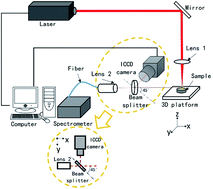An intensity correction method combined with plasma position information for laser-induced breakdown spectroscopy
Abstract
The uncertainty of collected spectral data is one of the most important issues for the application of laser-induced breakdown spectroscopy (LIBS) quantitative analysis. The fluctuation of the target surface simultaneously affects both the focus depth of the laser beam and the relative collection position, either of which may lead to severe fluctuation of the spectral signal. Thus, in this study, for detecting and reducing the fluctuation, an imaging system was deployed to monitor the plasma, and a mathematical model was also built based on both spectral signal and positional information. An ICCD camera was used to record the image of the plasma so as to detect the plasma and acquire positional information. Furthermore, the relationship between plasma position and specific spectral line intensity was obtained by the fitting function. Five aluminium alloy samples were employed to validate the reliability of the proposed method. As a result, the average RSDs of the samples (with a position fluctuation range of about 2 mm) in different spectral lines (Si 288.15 nm, Fe 273.95 nm, Cu 324.75 nm, Mn 259.37 nm and Mg 280.27 nm) were reduced from 34.57%, 38.86%, 31.05%, 39.74%, and 36.91% (without normalization) to 4.63%, 6.84%, 5.64%, 7.64%, and 4.83% (with the combination method presented in this paper), respectively; the determination coefficients (R2) reached 0.996, 0.999, 0.989, 0.999, and 0.9999, respectively. These results prove that the proposed method can both improve measurement reliability and guarantee measurement accuracy.



 Please wait while we load your content...
Please wait while we load your content...